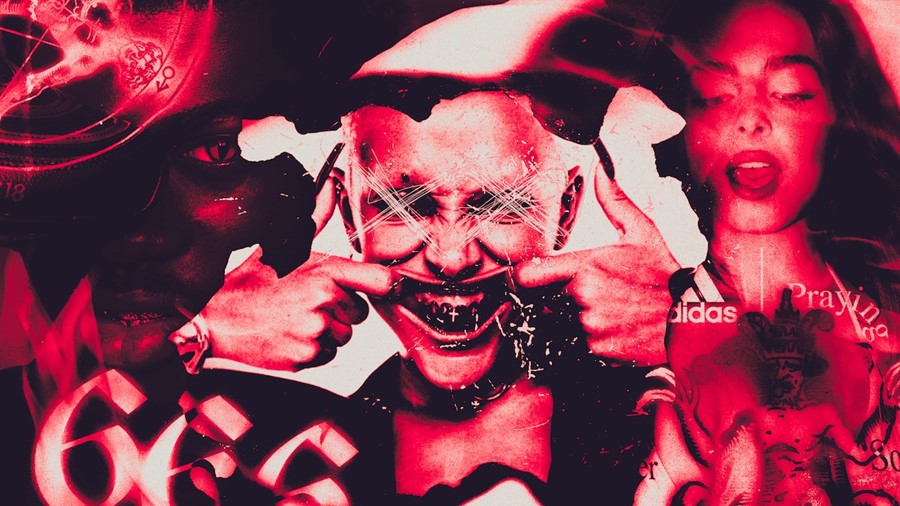From Doja Cat and Lil Nas X to Balenciaga and Addison Rae, Satanic conspiracy theories are spreading across social media like hellfire – but where have they all come from?
Doja Cat pulls a face on the cover of Dazed’s winter 2022 edition and is accused of worshipping Satan. Lil Nas X ignites rage among right-wing commentators after dropping 666 pairs of shoes made from human blood. Addison Rae poses in Praying’s iconic Holy Trikini and suddenly she’s the devil incarnate. Whether it’s pop stars, influencers, or the recent Balenciaga controversy, a moral panic has taken hold online. From the dark recesses of 4chan, baseless conspiracies are creeping out into the mainstream, as ideas spread by groups like QAnon take root in far-right politics and spread like hellfire across social media. According to these TikTok explainers and Twitter threads, “global elites” are partaking in the ritual sacrifice of children to harvest “adrenochrome” from their blood and retain eternal youth.
While the idea that a shadowy cabal kidnaps children, tortures them, and uses their blood in devilish rituals might sound absurd, it’s a narrative that has resurfaced in recent years mostly across American culture and politics (though it’s been an age-old favourite among right-wing commentators for decades). However, in a move that mirrors the more general radicalisation of thought online, as well as the growing popularity of trad aesthetics like catholicism, this latest wave of panic isn’t just limited to god-fearing fundamentalists with “Blue Lives Matter” in their Insta bio – its swept up average teens and so-called liberals too.
The original “Satanic Panic” took place in America during the 80s and early 90s. At the time, the media was filled with depictions of godless teens dressed in all-black, being brainwashed by hidden Satanic messages in rock and heavy metal music. Even table-top fantasy board games like Dungeons and Dragons were considered to be a sinister conduit for the devil. The societal fear of the occult reached a fever pitch when rumours began to swirl that an underground network of devil worshippers was infiltrating daycare centres across the country, to abuse children and use them in occult rituals (allegations that were, obviously, proved false). The exact cause of this mass hysteria is still unknown, but some historians have blamed it on the era’s financial recession, which saw an increase in conservative attitudes. People began to seek solace in tradition, religion and the nuclear family – anything that set itself against those ideals was seen as a threat.
The history of “adrenochrome” goes back even further. The conspiracy has its roots in a hateful, anti-Semitic myth that swept across Europe in the middle ages, which falsely accused Jewish people of conspiring to kill children and use their blood for religious rites. Like the Satanic Panic of the 1980s, the conspiracy emerged at a time of social upheaval, as a backlash against widespread corruption within the Catholic church.
By extension, it doesn’t take long to glean that the latest rush of Satanic Panic is less about blood-sucking elites and more about the uncertain times we live in. People are now turning to all kinds of alternative narratives to try and make sense of the chaotic world around them. This is especially true as distrust in traditional media institutions grows, and TikTok becomes the fastest-growing news source for young people. As neoliberalism further erodes our quality of life – mediaeval peasants supposedly worked less and relaxed more than the average person today – the gap between the rich and poor grows wider. This is the same for official news sources that are reliant on big donors with their own agendas. Ironically it’s these actual blood-sucking elites – usually right-wing pundits and big tech corps – who pedal sensationalist narratives to distract us from the actual problems at hand, which they are responsible for.
There is some truth underneath all these theories. There is a powerful group of elites who control the world around us for their own financial gain, for example, but just not in the way many conspiracy theorists would have us believe. Similarly, adrenochrome does technically exist: it’s a chemical compound that’s a byproduct of adrenaline. Although it doesn’t hold the secret to eternal youth, there’s some speculation that it could be linked to schizophrenia, which is why it caught the interest of dystopian, drug lit writers like Aldous Huxley, Anthony Burgess, and Hunter S Thompson in the mid-20th century. In Fear and Loathing in Las Vegas, Thompson posited the fictional notion that adrenochrome has psychoactive properties, and that it could be violently extracted from the adrenaline glands of a living human body (a YouTube clip featuring this apparent “extraction”, from the 1998 film adaptation of Fear and Loathing, has 58 million views).
Although the Satanic Panic left mainstream conversation in the early 90s, some would argue that it never really went away. If anything, the internet has given it a bigger and more accessible platform, where these conspiracies can fester and mutate. We’ve seen this particularly over the last decade, with the rise of social media: one of the most headline-grabbing instances is 2016’s Pizzagate, which claimed that democratic politicians were running a child sex-trafficking ring in the basement of a Washington pizzeria (there’s no basement). Another target was Marina Abramovic, who, in the same year, was accused of practicing satanic rituals at a dinner party. The rumours followed her into 2020, when conspiracy theorists shut down a collaboration she worked on with Microsoft.
It’s understandable that, in this atmosphere of media distrust, it’s easier to speculate about fictional child abuse cults than it is to hold accountable the Powers That Be. As social media tears apart any notion of a consensus reality, and western ideas of the anthropocene destroy our natural resources, it feels like modern science – and its promises of a better, fairer world – has betrayed us. Technology is accelerating at a dizzying pace and algorithms are becoming more advanced. This makes our lives feel more out of control than ever, while pushing an ideological evolution that feeds into Big Tech’s motives. Conspiracies like adrenochrome or Satan revealing himself in a Dazed cover, theories that are no doubt multiplied by the algorithm, are all ways of distracting us from more alarming realities.
But we must also ask ourselves why we’re collectively drawn to Christian notions of the devil to begin with, especially when many of the people spreading these conspiracies online aren’t even religious. Perhaps it’s boredom, a thirst for outlandish escapism, or the sort of memey curiosity that has people watching Ancient Aliens. Still, just as the OG Satanic Panic had people condemning goths for stepping outside of conventional narratives, the current targets of these devilish conspiracies are just people going against whatever traditionalists think is acceptable – and usually, it’s just people trying to be edgy. As for the liberals losing their minds over celebrity merch drops and fashion campaigns, why not interrogate the social and systematic conditions that cause, conceal and perpetuate actual child abuse? As Lil Nas X said: “Me sliding down a CGI pole isn’t what’s destroying society.” Maybe it’s the actual demons controlling our datastreams that we should be concerned about.
Join Dazed Club and be part of our world! You get exclusive access to events, parties, festivals and our editors, as well as a free subscription to Dazed for a year. Join for £5/month today.




